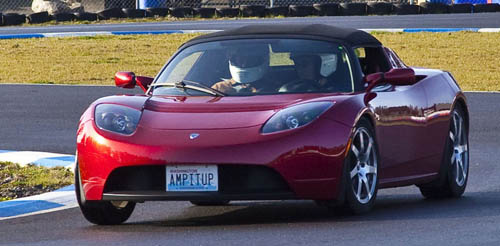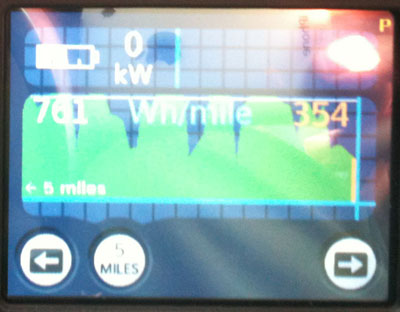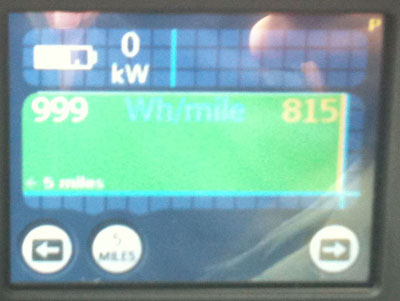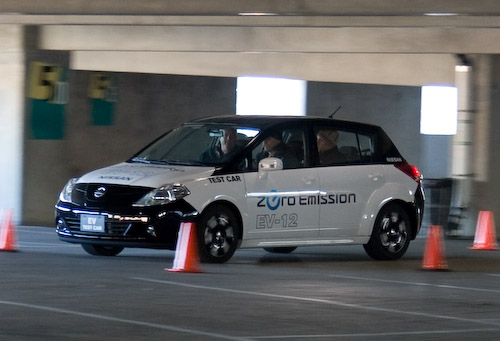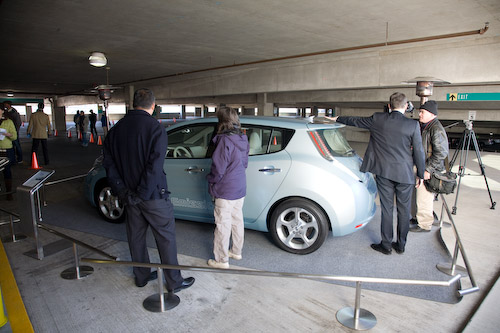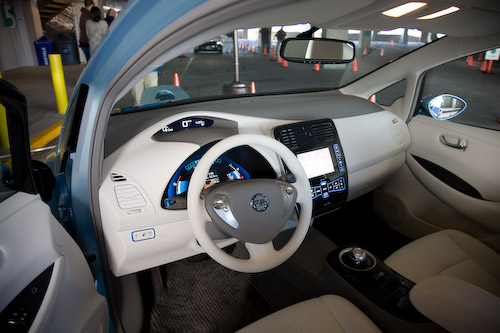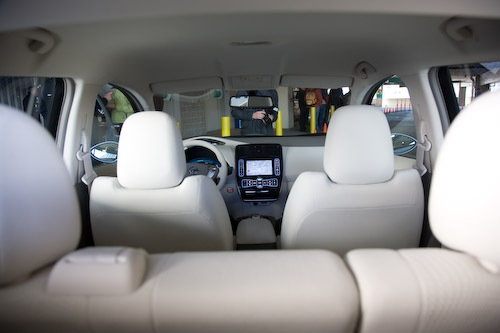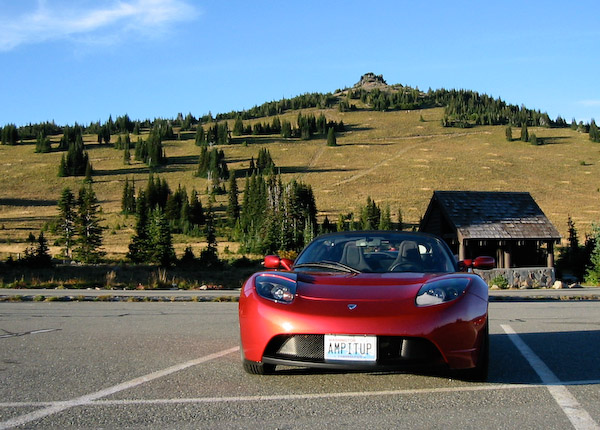Here's the secret formula for EV success: make sure the range of the vehicle suits the driving you plan to do with it. I know that sounds pretty obvious and easy, but there are two big barriers to success: bad reporting in the media and obfuscation by the automakers. There's also a bit of complexity: just like gas mileage, you can't express EV range with a single number. I'll get that all straightened out from the perspective of someone who has been driving all electric for almost two years.
In addition to the general facts of driving electric, we recently got some more specific range numbers for the upcoming Nissan Leaf which I'd like to put into perspective for potential buyers.
Reporting the Obvious and Irrelevant
If you follow EV coverage in the press, you'll find a steady stream of articles from reporters who think they've discovered the flaw that will deflate all of the hype about EVs. Their basic premise is that EVs won't work because they take too long to charge and there's nowhere to charge them. These articles are either totally made up, or based on the bad experience of a single EV driver and don't represent the real experience of the majority of EV drivers who purchased a vehicle appropriate for their needs. My purpose here is to make sure you don't become the excuse for some lazy reporter to write yet another of these uninsightful articles.
Would a newspaper publish an article about a Ford Focus owner who was disappointed that he couldn't fit his wife and seven kids in the car? How about a Honda Civic owner who's mad her car isn't suited for towing an RV? A Hummer owner who's mad about how much it costs to drive a mile? Of course not, these would be laughably obvious mistakes made by the owner in choosing a car.
For the consumer properly informed on the benefits and limits of electric vehicles, it's equally obvious that buying an EV with a 75-mile range to do a daily 74-commute with no charging infrastructure isn't going to yield a happy driver. That's obvious and boring.
The real story is that there is no problem with range or lack of charging infrastructure if you can just charge at home to meet your driving needs, instead it's a real convenience not to have to fuel your car away from home. So let's see if you qualify...
The Rule
To be a happy EV owner today, you want to buy a car that has enough single-charge range to handle all of your daily driving with a reasonable buffer for typical errands without needing to charge anywhere other than your charger. (Your charger is probably installed at your home but might also be at your work location.)
The good news is that for most drivers, the required range is surprisingly low. A 2003 US Department of Transportation survey (PDF) found that 78% of Americans drive less than 40 miles a day. If you're in the 78%, and don't often have big exceptions to that daily commute distance, then an EV that gets at least 70 miles of range in your driving conditions will most likely make you one happy camper. (But keep reading to learn how to evaluate EV range.)
Starting this fall, we'll start to see a lot of chargers getting installed in a few metro areas in the US and other countries. As this happens, and EV ownership goes up, more and more charging will become available and convenient. As that happens, charging away from your home charger will become more dependable and the usable range of EVs will expand as a result. For example, if you can charge at home and at work, then the usable range of an EV is doubled because you only need to travel one way on a single charge (with a reasonable buffer).
Since there's going to be limited availability of affordable, practical, freeway-capable EVs in the near future (as in zero today, and a few thousand Nissan Leafs starting to trickle out starting in December of this year, then more from other automakers to follow), it's OK if the first few models of EVs don't work for you, they will work for millions of potential buyers. Wait for an EV that will be right for your driving needs.
The Win
After you've driven electric for a month, spending just a few seconds to plug in each night to start every day with a full charge, without ever having to stop at a gas station, you'll wonder how you ever tolerated the hassles of driving a gas burner.
In addition, the experience of driving electric is just better: you get instant acceleration without waiting for the engine to rev up and the transmission to shift, another nuisance of driving gas that you'll only notice when you get used to driving without it.
Bonus: no tailpipe emissions, low-to-zero emissions from electricity generation, and never having to worry about the price at the gas pump.
Evaluating EV Range
Just like gas mileage, EV range can't be expressed as a single number. Even the two EPA city and highway gas mileage numbers you see on vehicle stickers don't tell the whole story. This is such a big issue with gas cars, the caveat "your mileage may vary" has become part of our cultural vernacular.
Let's start by going over how gas mileage works. Those gas mileage numbers on the sticker in the window are determined by driving the car on two standard EPA driving profiles meant to simulate typical driving conditions, which have been recently revised to better represent actual driving conditions by including things like using air conditioning on part of the cycle.
Gas mileage depends on a number of factors, including passenger and cargo weight, HVAC use, start/stop frequency, road incline, rain/snow, and so forth, but the biggest factor is speed. At low speeds, gas mileage suffers because there's an overhead of running/idling an engine that burns fuel whether you're moving or not. Stop and go traffic is also bad news, because you invest energy in speeding up only to throw all it all away by converting your car's momentum into heat plus wear and tear on your brake pads. At higher speeds gas mileage suffers because wind resistance goes up rapidly with speed, so much so that it takes more energy per mile in a way that starts increasing dramatically at the low end of freeway speeds. Somewhere in the middle, at a moderate, steady speed, is where you get your maximum gas mileage.
Electric vehicles behave similarly, except they get punished less in stop and go traffic because, like hybrids, they can slow down with regenerative braking wherein the motor is driven by the drivetrain to act as a generator to put charge back into the batteries. This not only improves energy efficiency, but also reduces brake wear.
Given this complexity, how can an automaker tell you how your gas or electric car will perform under your driving conditions? Answer: they can't.
While you can argue that it's even more important to understand energy efficiency (in the form of single-charge range) for an electric vehicle, there's the ugly truth about burning gas that no one likes to talk about: it's no good for predicting long-term fuel costs. With a proliferation of gas stations everywhere, range isn't something you think about for a gas car. What you do think about is your pocketbook. Better mileage means cheaper stops at the gas station. While knowing your gas mileage might tell you what you'll be spending at the pump this month, it doesn't say anything about what you'll be paying next month or next year. Anything from a hurricane, to Wall Street speculators, to a political action by OPEC, to the whim of some oil nation tyrant can cause gas prices to double by barely nudging the precarious balance between world oil supply and demand. Electricity rates are far more stable, especially when it comes from renewable sources that aren't subject to the unpredictable economic forces that rule the world's fossil fuel energy market.
How can a potential buyer figure out if a given EV has the range required to convert from the hassles of driving gas to the joy of driving electric? Read on...
Case Study: the Range of a Tesla Roadster
For most people, buying a $109,000 two-seat sports car is totally out of the question, whether it's a gas-burning Ferrari or an all-electric Tesla Roadster. Being able to go from 0 to 60 mph in under four seconds isn't going to get the kids to school or bring home the groceries from Costco. But, as of this writing, Tesla Motors is the only automaker selling a production, freeway capable electric vehicle in the US. If you dig a little, their web site provides a wealth of information about driving electric that will be of help to any potential EV driver.
The best illustration I have found of the effect of speed on efficiency, and thus range, is this graph from Tesla Motors showing how the Roadster's range varies with speed, while holding other factors constant at favorable values (constant speed, no AC, no driving up a mountain, etc.).

The EPA range number for the Roadster is 244 miles. From the graph, you can see that you get that range driving at about 55 mph. If you have to pick one number to describe range for a Roadster encompassing city and highway driving, this is a pretty good choice, and it's a real number that I've personally verified as much as possible without actually driving the car until it stops. Likewise, the value of about 180 miles for 70 mph matches my real-world experience. Simon Hackett and co-driver Emilis Prelgauskas came close to the graph's 34 mph range number by driving 313 miles on a single charge in Australia last year. Perhaps someone will be patient enough to try out the 17 mph peak on the graph at over 400 miles of range, but that would be a very long drive!
I'd say Tesla did a good job here, picking a reasonable single number for stating range based on some combination of the EPA city and highway cycles. They also provide the graph showing the whole story, at least with respect to speed, although to find it you have to dig down into their blog entries to find the article with the graph and full explanation.
But there's a bit more to the story that requires more digging. The above range numbers are for using the entire battery charge from full to empty, something you really don't want to do on a regular basis because it's not good for the life of the battery pack. For normal daily driving, you don't need 244 miles of range, so Tesla provides a "standard" mode of charging that only uses the middle 80% of the battery pack. This will extend the life of the battery pack and still give you 200 miles of range at 55 mph, or about 160 miles at 70 mph. This is between four and five times what most of the drivers in the US need for their daily commute. For daily driving, the range of the Roadster is ridiculously high. Going on a road trip beyond the single charge range is doable, but it requires patience and planning. This situation will get a lot better as high-speed charging stations start to appear later this year.
The numbers also get worse in really hot weather. Last summer I drove from Portland to Seattle in 100-degree weather, about 180 miles. This trip is easy at 55, in fact even at 65 mph it's no problem. But this trip, with the HVAC system using energy to keep the battery pack cool, it took getting off the freeway and careful route planning to reduce both distance and speed to get home without having to stop for a partial charge.
The upshot: if you live in an extreme climate, with either a lot of sub-zero winter days or 100+ degree summer days, you'll want to add more buffer to your required EV range.
The last big issue is aging of the battery pack: as the battery pack ages, its capacity will decrease gradually over time, then drop more rapidly as the battery pack wears out. Our car is performing the same as it did when we got it one year and 9,000 miles ago. Other Roadster owners have crossed the 20,000 mile mark, and so far I haven't heard of anyone noticing a loss of range. Tesla's battery pack warranty is only 3 years or 36,000 miles, which is in line with other high performance sports cars, but is a bit underwhelming compared to their statements of expected battery life, seven years or 100,000 miles. Nissan says their battery pack should last 10 years, and because the Leaf is a much more mainstream vehicle I expect they will offer a much better battery warranty.
Still, if you're planning to drive your new EV for 5 to 10 years, it's not going to be smart to buy an electric car that's right on the edge of meeting your needs with its full factory-fresh range.
Our Electric Garage
In July of 2008, while we were waiting for Tesla to build the Roadster we reserved in 2006, we were fortunate enough to buy a rare 2002 Toyota RAV4-EV from its original owner in Berkeley, CA. If you've seen Who Killed the Electric Car, then you've know what a great electric driving experience the lucky few drivers had during the brief period where California required all of the automakers to find a way to reduce tailpipe emissions to zero.
When we got the RAV4-EV, we expected it would take care of about half of our driving. We were wrong by a wide margin: it took over 95% of our driving. The only time we burned gas was when we each had to be different places at the same time. Despite our EV enthusiasm, we were range anxiety victims and overestimated how much range our driving really required.
In our experience, the RAV4-EV gets about 100 miles per charge. Even staying out of the top 10% and bottom 20% of the battery pack means we can drive 70 miles per charge under our typical driving conditions, and can handle any driving conditions with enough range we don't generally have to think about it.
When our Roadster finally arrived nearly a year later, we were totally converted to the electric driving experience. Having a second electric car meant we didn't have to choose which of us got to drive the smooth, quiet car.
Our hope is that the Leaf will bring this sort of EV capability into the mainstream in an affordable, practical, safe vehicle.
Nissan Leaf Range Numbers
The first range number we heard for the Nissan Leaf was 100 miles using the EPA's LA4 drive cycle. Darryl Siry gets credit for being the first to point out that the LA4 drive cycle is a poor choice for describing EV range as it's a city driving cycle that's nicer to the range than the combined city/highway drive cycle that is used by Tesla. Siry also wrote a great piece on the issues with range numbers and the need for federal regulations on how they are reported which added perspective to my personal experience and helped inform my writing here.
On June 19th 2010, we got some more range numbers from Nissan via Forbes. To summarize:
- Cruising at 38 mph in 68-degree weather: 138 miles.
- Suburban traffic averaging 24 mph, 77 degrees: 105 miles.
- Urban highway, 55 mph, 95-degrees, A/C on: 70 miles.
- Winter city driving, 14 degrees, averaging 15 mph: 62 miles.
- Stop and go urban traffic averaging 6 mph, 86 degrees, A/C on: 47 miles.
The fact is, the Leaf doesn't have to meet the needs of every driver in the US. It just has to meet the needs of the few thousand people lucky enough to be able to buy one in the next year. Even that worst-case 47 miles is going to be good enough for millions of drivers now (remember that 78% of US drivers commute less than 40 miles per day) and good enough for even more drivers when there are convenient chargers at workplaces and malls.
Is the Leaf's Range Right for You?
I think the best way to figure out what range an EV needs to have to suit your needs is to monitor your driving. Just write down your odometer when you get home each night. From that, you can figure out how far you actually drive. Be sure to get not only your regular daily commute, but also some examples of exceptional days with extra appointments, shopping, detours, etc. If you have an additional vehicle that would supplement your EV, throw out any long drives that you would choose (in advance) to handle with that vehicle. Then add a buffer for the unexpected, and, if it applies, more buffer for the extreme driving conditions that reduce range.
People who haven't driven an EV will be tempted to always have half of the battery in reserve for surprises, but most experienced EV drivers are very comfortable driving down to 30% or even 20%. (With the Roadster where I get great feedback on the state of charge and know it won't hurt the battery, I have no problem driving down to 10%. With the RAV4-EV, which gives less precise info, we try to stay out of the bottom 20%.)
If you commute 70 or more miles per day in a city that regularly has horrible traffic, freezing cold or sweltering hot days, and isn't planning for charging infrastructure, then don't buy a Leaf to be your only car this year. Wait until the cars and the charging better suit your driving needs. There are more than enough of us to buy up every single Leaf Nissan can make in the next 12 months, so don't become fodder for another annoying article about how EVs are impractical because someone bought one that's not suited to their driving.
If the Leaf's range numbers do suit your driving needs and you want to get an early start driving electric, then sign up, right now. They are going to sell fast. But before you fully commit to a purchase, get the information you need to determine if the Leaf will meet your needs, and get that info directly from Nissan. Don't depend on a conversation with your local auto sales drone.
I'm glad we have learned more about the Leaf's range months before anyone will be committed to buying one. Next up I want to see a graph like Tesla gives for the Roadster range vs. speed under optimal driving conditions. I also want to know if the range numbers given are for using the full battery to its maximum range, or if they include allowance for the reserves at the top and bottom of the charge cycle needed to maximize battery life.
If the Leaf will meet your needs, you won't regret switching away from gas. The benefits of charging convenience and drivability are great motivators to be among the early adopters to buy one of the first mainstream factory electric vehicles.
